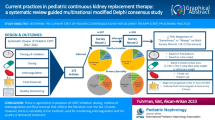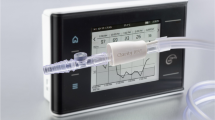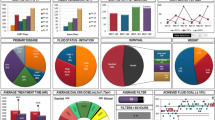Abstract
Background
Initiation of continuous kidney replacement therapy (CKRT) greater than 20% fluid overload is associated with increased morbidity and mortality. We aimed to reduce the number of patients initiated on CKRT greater than 20% fluid overload by 50% in one year by implementation of a quality improvement initiative.
Methods
This is a prospective quality improvement study set in a pediatric ICU of an urban children’s hospital of patients initiated on CKRT over 2 years. The intervention included creation of an electronic health record order for daily calculation of net percent fluid overload, incorporation into daily rounds, and education programs tailored to physicians and bedside nursing. We measured adherence with the new order set, percent fluid overload at CKRT initiation, days on CKRT, timing of first nephrology consultation, and death prior to discharge.
Results
A total of 32% of patients were initiated on CKRT greater than 20% fluid overload pre-initiative and 9% post-initiative, a 72% reduction over 13 months. Patients initiated on CKRT greater than 20% fluid overload had median CKRT course of 8 (IQR 4–14) vs. 22 days (IQR 13.5–62).
Conclusion
Creating a system using EHR with education may reduce initiation of CKRT after development of severe fluid overload.
Graphical abstract
A higher resolution version of the Graphical abstract is available as Supplementary information.





Similar content being viewed by others
Data availability
The datasets generated during and/or analyzed during the current study are available from the corresponding author on reasonable request.
References
Belsha CW, Kohaut EC, Warady BA (1995) Dialytic management of childhood acute renal failure: a survey of North American pediatric nephrologists. Pediatr Nephrol 9:361–363
Ricci Z, Ronco C, D’Amico G, De Felice R, Rossi S, Bolgan I, Bonello M, Zamperetti N, Petras D, Salvatori G, Dan M, Piccinni P (2006) Practice Patterns in the management of acute renal failure in the critically ill patient: an international survey. Nephrol Dial Transplant 21:690–696
Warady BA, Bunchman T (2005) Dialysis therapy for children with acute renal failure: survey results. Pediatr Nephrol 15:11–13
Zobel G, Ring E, Rodl S (1995) Prognosis in pediatric patients with multiple organ system failure and continuous extracorporeal renal support. Contrib Nephrol 116:163–168
Lane PH, Mauer SM, Blazar BR, Ramsey NK, Kashtan CE (1994) Outcome of dialysis for acute renal failure in pediatric bone marrow transplant patients. Bone Marrow Transplant 13:613–617
Goldstein SL, Currier H, Graf JM, Cosio CC, Brewer ED, Sachdeva R (2001) Outcome in children receiving continuous venovenous hemofiltration. Pediatrics 107:1309–1312
Foland J, Fortenberry J, Warshaw B, Pettignano R, Merritt R, Heard M, Rogers K, Reid C, Tanner A, Easley K (2004) Fluid overload before continuous hemofiltration and survival in critically ill children: a retrospective analysis. Crit Care Med 32:1771–1776
Gillespie RS, Seidel K, Symons JM (2004) Effect of fluid overload and dose of replacement fluid on survival in hemofiltration. Pediatr Nephrol 19:1394–1399
Hayes LW, Oster RA, Tofil NM, Tolwani A (2009) Outcomes of critically ill children requiring continuous renal replacement therapy. J Crit Care 24:394–400
Goldstein SL, Somers MJ, Baum MA, Symons JM, Brophy PD, Blowey D, Bunchman TE, Baker C, Mottes T, McAfee N, Barnett J, Morrison G, Rogers K, Fortenberry JD (2005) Pediatric patients with multi-organ dysfunction syndrome receiving continuous renal replacement therapy. Kidney Int 67:653–658
Sutherland SM, Zappitelli M, Alexander SR, Chua AN, Brophy PD, Bunchman TE, Hackbarth R, Somers MJ, Baum M, Symons JM, Flores FX, Benfield M, Askenazi D, Chand D, Fortenberry JD, Mahan JD, McBryde K, Blowey D, Goldstein SL (2010) Fluid overload and mortality in children receiving continuous renal replacement therapy: the prospective pediatric continuous renal replacement therapy registry. Am J Kidney Dis 55:316–325
Selewski D, Cornell T, Lombel R, Blatt NB, Han YY, Mottes T, Kommareddi M, Kershaw DB, Shanley TP, Heung M (2011) Weight-based determination of fluid overload status and mortality in pediatric intensive care unit patients requiring continuous renal replacement therapy. Intens Care Med 37:1166–1173
Davies H, Leslie G, Jacob E, Morgan D (2019) Estimation of body fluid status by fluid balance and body weight in critically ill adult patients: a systematic review. Worldviews Evid Based Nurs 16:470–477
Koster M, Dennhardt S, Juttner F, Hopf H (2016) Cumulative changes in weight but not fluid volume balances reflect fluid accumulation in ICU patients. Acta Anaesth Scand 61:205–215
Ogrinc G, Davies L, Goodman D, Batalden P, Davidoff F, Stevens D (2016) SQUIRE 2.0 (Standards for Quality Improvement Reporting Excellence): revised publication guidelines from a detailed consensus process. BMJ Qual Saf 25:986–992
Alobaidi R, Morgan C, Basu R, Stenson E, Featherstone R, Majumdar SR, Bagshaw SM (2019) Association between fluid balance and outcomes in critically ill children. JAMA Pediatr 172:257–268
Al-Lawati ZH, Sur M, Kennedy C, Arikan AA (2020) Profile of fluid exposure and recognition of fluid overload in critically ill children. Pediatr Crit Care Med 21:760–766
Rubins D, Boxer R, Landman A, Wright A (2019) Effect of default order set settings on telemetry ordering. J Am Med Inform Assoc 26:1488–1492
Buntin M, Burke M, Hoaglin M, Blumenthal D (2011) The benefits of health information technology: a review of the recent literature shows predominantly positive results. Health Affair 30:464–471
Barhight MF, Nelson D, Chong G, Basu RK, Sanchez-Pinto LN (2022) Non-resuscitation fluid in excess of hydration requirements is associated with higher mortality in critically ill children. Pediatr Res 91:235–240
Author information
Authors and Affiliations
Corresponding author
Ethics declarations
Conflict of interest
The authors declare no competing interests.
Additional information
Publisher's Note
Springer Nature remains neutral with regard to jurisdictional claims in published maps and institutional affiliations.
Supplementary Information
Below is the link to the electronic supplementary material.
Rights and permissions
About this article
Cite this article
Nelson, D.R., Keswani, M., Finn, L. et al. A quality initiative to improve recognition of fluid overload among pediatric ICU patients requiring continuous kidney replacement therapy: preliminary results. Pediatr Nephrol 38, 557–564 (2023). https://doi.org/10.1007/s00467-022-05584-4
Received:
Revised:
Accepted:
Published:
Issue Date:
DOI: https://doi.org/10.1007/s00467-022-05584-4




